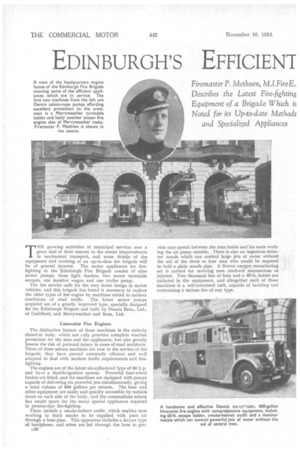EDINBURGH'S EFFICIENT
Page 96

If you've noticed an error in this article please click here to report it so we can fix it.
Firemaster P. Methuen, M.I.Fire E. Describes the Latest Fire-fighting Equipment of a Brigade Which is Noted for its Up-to-date Methods and Specialized Appliances
THE growing activities of municipal services owe a great deal of their success to the recent improvements in mechanical transport, and some details of the equipment and working of an up-to-date fire brigade will be of general interest. The motor appliances for firefighting in the Edinburgh Fire Brigade consist of nine motor pumps, three light tenders, two motor turntable escapes, one monitor wagon and one trailer pump.
The fire service calls for the very latest design in motor vehicles, and this brigade has found it necessary to replace the older types of fire engine by machines suited to modern conditions of road traffic. The latest motor pumps acquired are of a greatly improved type, specially designed for the Edinburgh Brigade and built by Dennis Bros., Ltd., of Guildford, and Merryweather and Sons, Ltd.
Limousine Fire Engines.
The distinctive feature of these machines is the entirely closed-in body, which not cnly provides complete weather protection for the men and the appliances, but also greatly lessens the risk of personal injury in cases of road accidents. Three of these saloon machines are now in the service of the brigade; they have proved extremely efficient and well adapted to deal with modern traffic requirements and firefighting.
The engines are of the latest six-cylindered type of 90 h.p. and have a double-ignition system. Powerful four-wheel brakes are fitted, and the machines are equipped with pumps capable of delivering six powerful jets simultaneously, giving a total volume of 600 gallons per minute. The hose and other equipment are easily and quickly accessible by outside
• doors on each side of the body, and the commodious saloon has ample space for the many special appliances required in present-day fire-fighting.
These include a smoke-helmet outfit, which enables men working in thick smoke to be supplied with pure air through a hose pipe. This apparatus includes a larynx type of headphone, and wires are led through the hose to pro
c30
vide easy speech between the man inside and his mate working the air pump outside. There is also an ingenious monitor nozzle which can control large jets of water without the aid of the three or four men who would be required to hold a plain nozzle pipe. A Novox oxygen resuscitating set is carried for reviving men rendered unconscious or injured. Two thousand feet of hose and a 40-ft. ladder are included in the equipment, and altogether each of these machines is a self-contained unit, capable of tackling and overcoming a serious fire of any type.




















































































































































































